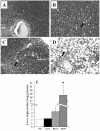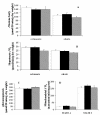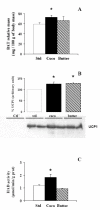Long term highly saturated fat diet does not induce NASH in Wistar rats
- PMID: 17313679
- PMCID: PMC1805500
- DOI: 10.1186/1743-7075-4-4
Long term highly saturated fat diet does not induce NASH in Wistar rats
Abstract
Background: Understanding of nonalcoholic steatohepatitis (NASH) is hampered by the lack of a suitable model. Our aim was to investigate whether long term high saturated-fat feeding would induce NASH in rats.
Methods: 21 day-old rats fed high fat diets for 14 weeks, with either coconut oil or butter, and were compared with rats feeding a standard diet or a methionine choline-deficient (MCD) diet, a non physiological model of NASH.
Results: MCDD fed rats rapidly lost weight and showed NASH features. Rats fed coconut (86% of saturated fatty acid) or butter (51% of saturated fatty acid) had an increased caloric intake (+143% and +30%). At the end of the study period, total lipid ingestion in term of percentage of energy intake was higher in both coconut (45%) and butter (42%) groups than in the standard (7%) diet group. No change in body mass was observed as compared with standard rats at the end of the experiment. However, high fat fed rats were fattier with enlarged white and brown adipose tissue (BAT) depots, but they showed no liver steatosis and no difference in triglyceride content in hepatocytes, as compared with standard rats. Absence of hepatic lipid accumulation with high fat diets was not related to a higher lipid oxidation by isolated hepatocytes (unchanged ketogenesis and oxygen consumption) or hepatic mitochondrial respiration but was rather associated with a rise in BAT uncoupling protein UCP1 (+25-28% vs standard).
Conclusion: Long term high saturated fat feeding led to increased "peripheral" fat storage and BAT thermogenesis but did not induce hepatic steatosis and NASH.
Figures

 different from standard.
different from standard.
 P < 0.01 vs standard diet.
P < 0.01 vs standard diet.
 P < 0.001 vs standard diet.
P < 0.001 vs standard diet.
 P < 0.05 vs standard.
P < 0.05 vs standard.

 P < 0.05. (B) Western blot analysis of UCP1 content in brown adipose tissue from rat fed standard diet, coconut diet or butter diet. Detections were performed with 40 μg of BAT mitochondrial proteins. Negative control was liver from standard rats. (C) 3-hydroxyacyl-CoA dehydrogenase (HAD) activity is measured spectrophotometrically and expressed in micromoles per minute per gram protein. Data are means ± SEM; n = 8 for standard group, coco group, and n = 4 for butter group.
P < 0.05. (B) Western blot analysis of UCP1 content in brown adipose tissue from rat fed standard diet, coconut diet or butter diet. Detections were performed with 40 μg of BAT mitochondrial proteins. Negative control was liver from standard rats. (C) 3-hydroxyacyl-CoA dehydrogenase (HAD) activity is measured spectrophotometrically and expressed in micromoles per minute per gram protein. Data are means ± SEM; n = 8 for standard group, coco group, and n = 4 for butter group.  P < 0.05.
P < 0.05.Similar articles
-
Energy restriction with high-fat diet enriched with coconut oil gives higher UCP1 and lower white fat in rats.Int J Obes Relat Metab Disord. 1998 Oct;22(10):974-9. doi: 10.1038/sj.ijo.0800706. Int J Obes Relat Metab Disord. 1998. PMID: 9806312
-
Chronic consumption of fructose in combination with trans fatty acids but not with saturated fatty acids induces nonalcoholic steatohepatitis with fibrosis in rats.Eur J Nutr. 2018 Sep;57(6):2171-2187. doi: 10.1007/s00394-017-1492-1. Epub 2017 Jul 4. Eur J Nutr. 2018. PMID: 28676973
-
Influence of dietary fats upon systolic blood pressure in the rat.Int J Food Sci Nutr. 1996 Sep;47(5):417-25. doi: 10.3109/09637489609006955. Int J Food Sci Nutr. 1996. PMID: 8889627
-
A mouse model for nonalcoholic steatohepatitis.J Nutr Biochem. 2011 Oct;22(10):979-84. doi: 10.1016/j.jnutbio.2010.08.011. Epub 2010 Dec 28. J Nutr Biochem. 2011. PMID: 21190824
-
A highly saturated fat-rich diet is more obesogenic than diets with lower saturated fat content.Nutr Res. 2010 Sep;30(9):632-43. doi: 10.1016/j.nutres.2010.09.003. Nutr Res. 2010. PMID: 20934605
Cited by
-
Dietary cholesterol, female gender and n-3 fatty acid deficiency are more important factors in the development of non-alcoholic fatty liver disease than the saturation index of the fat.Nutr Metab (Lond). 2011 Jan 24;8:4. doi: 10.1186/1743-7075-8-4. Nutr Metab (Lond). 2011. PMID: 21261989 Free PMC article.
-
High-fat and obesogenic diets: current and future strategies to fight obesity and diabetes.Genes Nutr. 2014 Jul;9(4):406. doi: 10.1007/s12263-014-0406-6. Epub 2014 May 20. Genes Nutr. 2014. PMID: 24842072 Free PMC article.
-
Experimental models of non-alcoholic fatty liver disease in rats.World J Gastroenterol. 2014 Jul 14;20(26):8364-76. doi: 10.3748/wjg.v20.i26.8364. World J Gastroenterol. 2014. PMID: 25024595 Free PMC article.
-
Dietary fat composition influences tissue lipid profile and gene expression in Fischer-344 rats.Lipids. 2012 Dec;47(12):1119-30. doi: 10.1007/s11745-012-3729-3. Epub 2012 Oct 20. Lipids. 2012. PMID: 23086552
-
Targeted Nutrient Modifications in Purified Diets Differentially Affect Nonalcoholic Fatty Liver Disease and Metabolic Disease Development in Rodent Models.Curr Dev Nutr. 2020 Apr 24;4(6):nzaa078. doi: 10.1093/cdn/nzaa078. eCollection 2020 Jun. Curr Dev Nutr. 2020. PMID: 32494762 Free PMC article.
References
-
- Ludwig J, Viggiano TR, McGill DB, Oh BJ. Nonalcoholic steatohepatitis: Mayo Clinic experiences with a hitherto unnamed disease. Mayo Clin Proc. 1980;55:434–438. - PubMed
-
- Clark JM, Brancati FL, Diehl AM. Nonalcoholic fatty liver disease. Gastroenterology. 2002;122:1649–1657. - PubMed
-
- Reid BM, Sanyal AJ. Evaluation and management of non-alcoholic steatohepatitis. Eur J Gastroenterol Hepatol. 2004;16:1117–1122. - PubMed
-
- Day CP. Pathogenesis of steatohepatitis. Best Pract Res Clin Gastroenterol. 2002;16:663–678. - PubMed
-
- Kumar KS, Malet PF. Nonalcoholic steatohepatitis. Mayo Clin Proc. 2000;75:733–739. - PubMed
LinkOut - more resources
Full Text Sources

